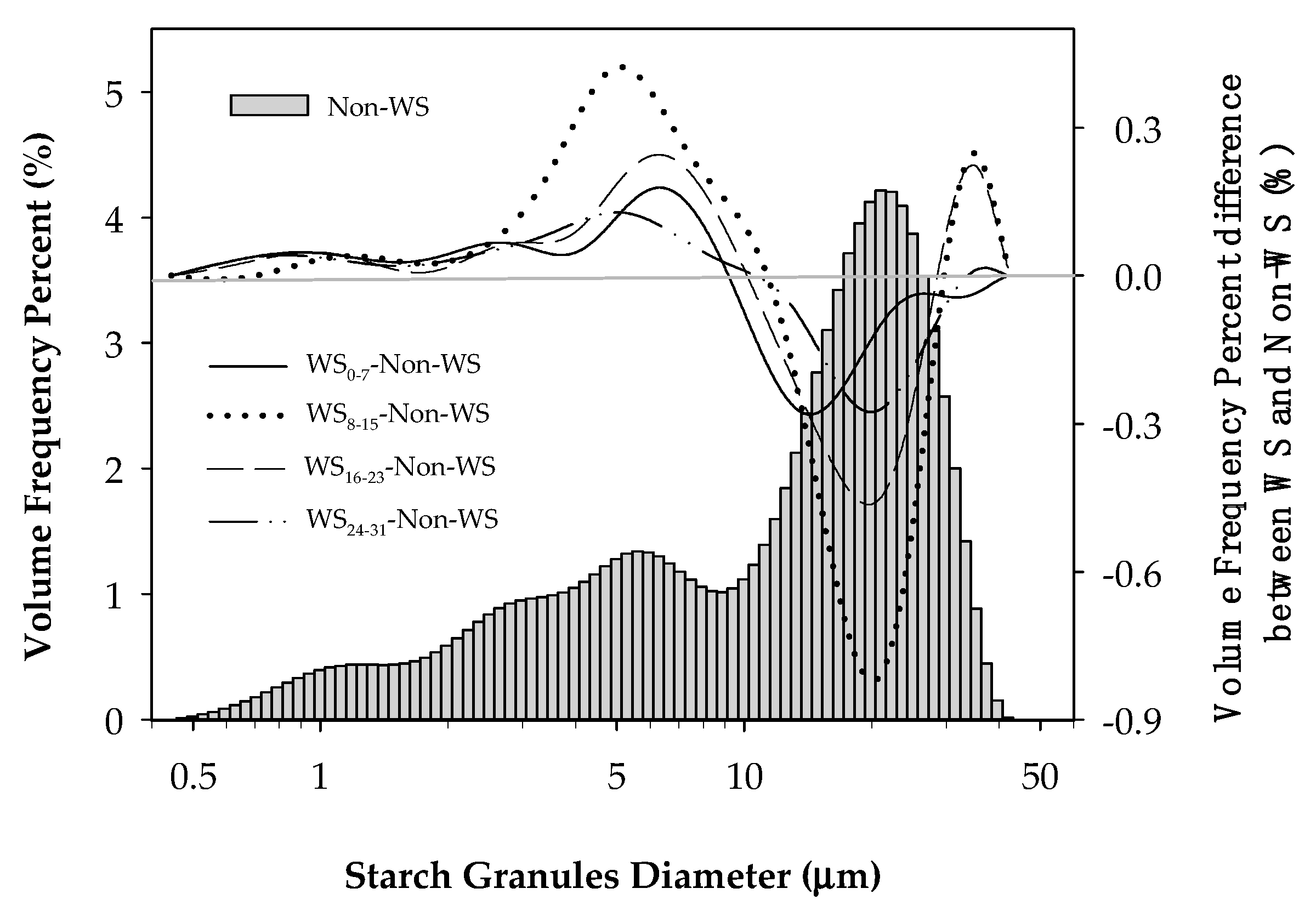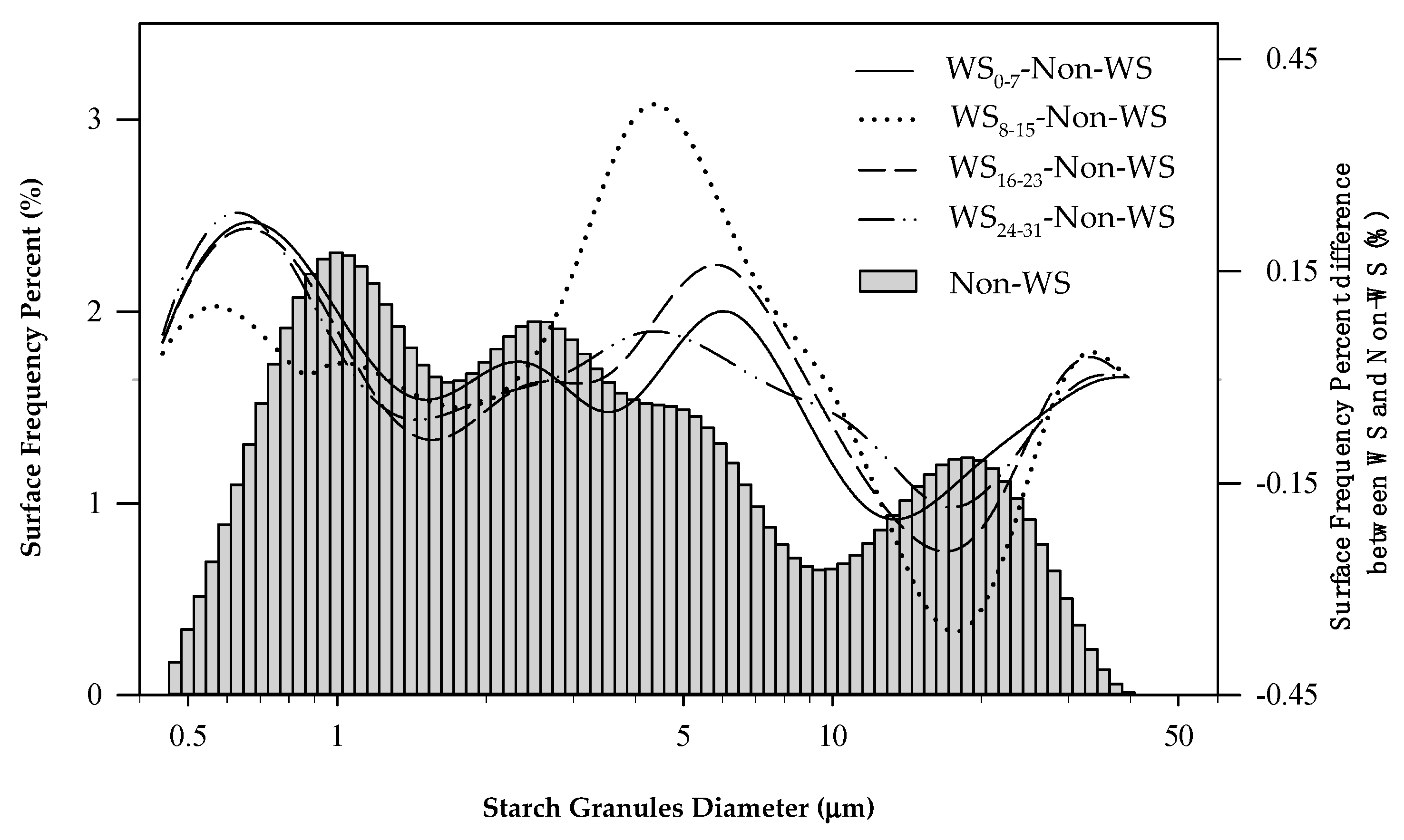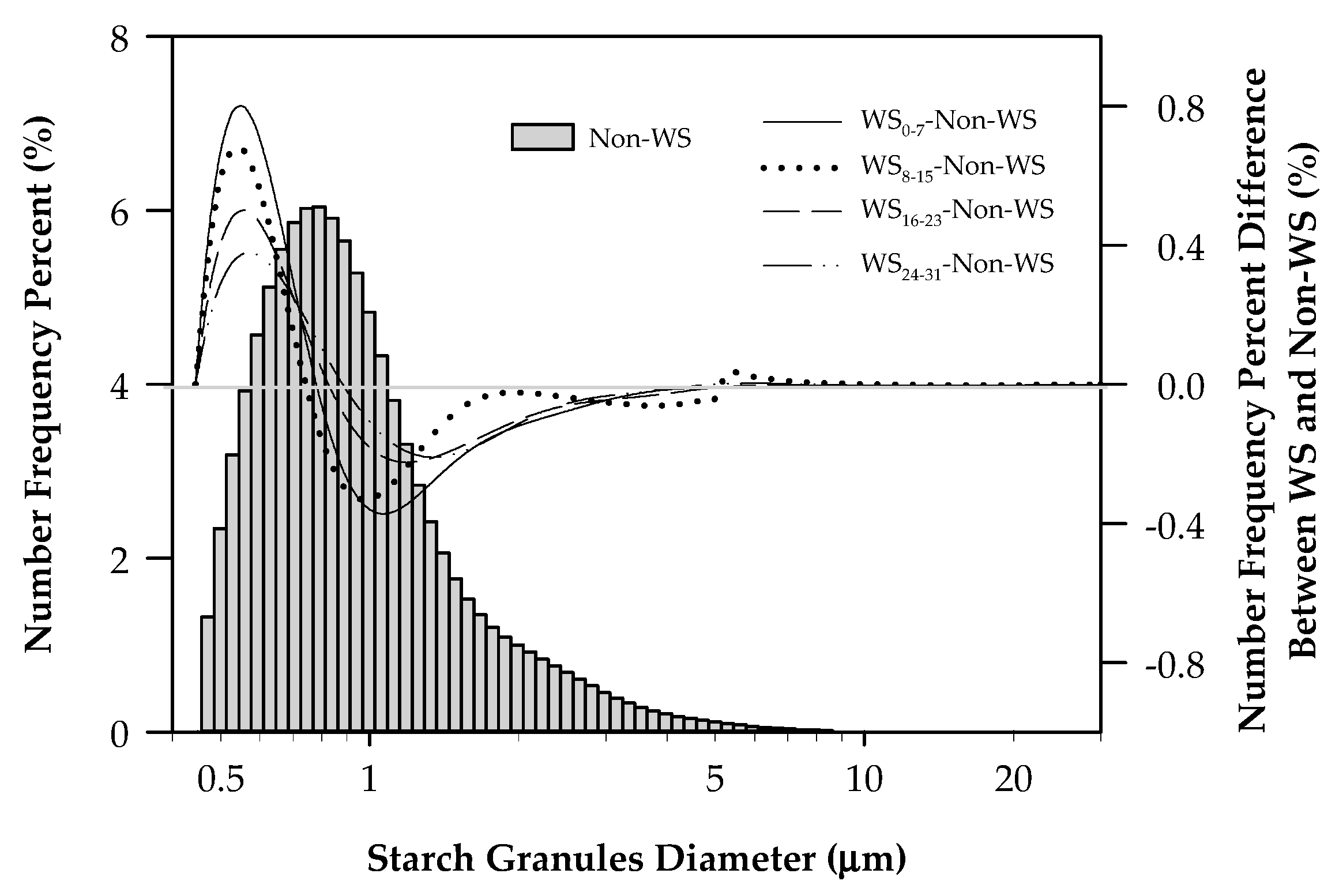Starch Granule Size Distribution and Pasting Characteristic Response to Post-Anthesis Combined Stress of Waterlogging and Shading
Abstract
:1. Introduction
2. Materials and Methods
2.1. Experimental Design
2.2. Measurement of Content of Starch, Starch Granule Size Distribution, and Starch Pasting Properties
2.3. Statistics
3. Results
3.1. Effect of Post-Anthesis WS Treatments on the Yield and the Pasting Characteristics of Starch in Wheat Mature Grains
3.2. Effect of Post-Anthesis WS Treatments on the Volume Distribution of Starch Granules in Mature Wheat Grains
3.3. Effect of Post-Anthesis WS Treatments on the Surface area Distribution of Starch Granules in Mature Wheat Grains
3.4. Effect of Post-Anthesis WS Treatments on the Number Distribution of Starch Granules in Mature Wheat Grains
3.5. Relationship between the Starch Content and Starch Pasting Characteristics of Wheat under Post-Anthesis WS Treatments
4. Discussion
5. Conclusions
Author Contributions
Funding
Conflicts of Interest
References
- Bechtel, D.B.; Zayas, I.; Kaleikau, L.; Pomeranz, Y. Size-distribution of wheat starch granules during endosperm development. Cereal Chem. 1990, 67, 59–63. [Google Scholar]
- Morell, M.; Rahman, S.; Abrahams, S.; Appels, R. The biochemistry and molecular biology of starch synthesis in cereals. Funct. Plant Biol. 1995, 22, 647–660. [Google Scholar] [CrossRef]
- Salman, H.; Blazek, J.; Lopez-Rubio, A.; Gilbert, E.P.; Hanley, T.; Copeland, L. Structure–function relationships in A and B granules from wheat starches of similar amylose content. Carbohydr. Polym. 2009, 75, 420–427. [Google Scholar] [CrossRef]
- Srichuwong, S.; Jane, J.-L. Physicochemical properties of starch affected by molecular composition and structures: A Review. Food Sci. Biotechnol. 2007, 16, 663–674. [Google Scholar]
- Pérez, S.; Bertoft, E. The molecular structures of starch components and their contribution to the architecture of starch granules: A comprehensive review. Starch Stärke 2010, 62, 389–420. [Google Scholar] [CrossRef]
- Zhang, B.; Li, X.; Liu, J.; Xie, F.; Chen, L. Supramolecular structure of A-and B-type granules of wheat starch. Food Hydrocoll. 2013, 31, 68–73. [Google Scholar] [CrossRef]
- Zhang, C.; Jiang, D.; Liu, F.; Cai, J.; Dai, T.; Cao, W. Starch granules size distribution in superior and inferior grains of wheat is related to enzyme activities and their gene expressions during grain filling. J. Cereal Sci. 2010, 51, 226–233. [Google Scholar] [CrossRef]
- Shinde, S.V.; Nelson, J.E.; Huber, K.C. Soft Wheat Starch Pasting Behavior in Relation to A- and B-type Granule Content and Composition. Cereal Chem. 2003, 80, 91–98. [Google Scholar] [CrossRef]
- Raeker, M.Ö.; Gaines, C.S.; Finney, P.L.; Donelson, T. Granule size distribution and chemical composition of starches from 12 soft wheat cultivars. Cereal Chem. 1998, 75, 721–728. [Google Scholar] [CrossRef]
- Gerits, L.R.; Pareyt, B.; Delcour, J.A. Wheat starch swelling, gelatinization and pasting: Effects of enzymatic modification of wheat endogenous lipids. LWT Food Sci. Technol. 2015, 63, 361–366. [Google Scholar] [CrossRef]
- Yan, Z.; Jinfeng, D.; Jianmin, S.; Gavin, H.S.; Yongxin, P.; Chunyan, L.; Xinkai, Z.; Wenshan, G. Grain yield, starch content and activities of key enzymes of waxy and non-waxy wheat (Triticum aestivum L.). Sci. Rep. 2018, 8, 4548. [Google Scholar]
- Meredith, P. Large and small starch granules in wheat–are they really different? Starch Stärke 1981, 33, 40–44. [Google Scholar] [CrossRef]
- Sandhu, K.S.; Sharma, L.; Kaur, M. Effect of granule size on physicochemical, morphological, thermal and pasting properties of native and 2-octenyl-1-ylsuccinylated potato starch prepared by dry heating under different pH conditions. LWT-Food Sci. Technol. 2015, 61, 224–230. [Google Scholar] [CrossRef]
- Guo, Q.; He, Z.; Xia, X.; Qu, Y.; Zhang, Y. Effects of Wheat Starch Granule Size Distribution on Qualities of Chinese Steamed Bread and Raw White Noodles. Cereal Chem. 2014, 91, 623–630. [Google Scholar] [CrossRef]
- Li, W.; Gao, J.; Wu, G.; Zheng, J.; Ouyang, S.; Luo, Q.; Zhang, G. Physicochemical and structural properties of A- and B-starch isolated from normal and waxy wheat: Effects of lipids removal. Food Hydrocoll. 2016, 60, 364–373. [Google Scholar] [CrossRef]
- Kaur, A.; Shevkani, K.; Katyal, M.; Singh, N.; Ahlawat, A.K.; Singh, A.M. Physicochemical and rheological properties of starch and flour from different durum wheat varieties and their relationships with noodle quality. J. Food Sci. Technol. 2016, 53, 2127–2138. [Google Scholar] [CrossRef] [Green Version]
- Panozzo, J.; Eagles, H. Cultivar and environmental effects on quality characters in wheat. I. Starch. Aust. J. Agric. Res 2000, 51, 629–636. [Google Scholar] [CrossRef]
- Wang, X.; Cai, J.; Liu, F.; Jin, M.; Yu, H.; Jiang, D.; Cao, W. Pre-anthesis high temperature acclimation alleviates the negative effects of post-anthesis heat stress on stem stored carbohydrates remobilization and grain starch accumulation in wheat. J. Cereal Sci. 2012, 55, 331–336. [Google Scholar] [CrossRef]
- Zhang, T.; Wang, Z.; Yin, Y.; Cai, R.; Yan, S.; Li, W. Starch content and granule size distribution in grains of wheat in relation to post-anthesis water deficits. J. Agron. Crop. Sci. 2010, 196, 1–8. [Google Scholar] [CrossRef]
- Ni, Y.; Wang, Z.; Yin, Y.; Li, W.; Yan, S.; Cai, T. Starch granule size distribution in wheat grain in relation to phosphorus fertilization. J. Agric. Sci. 2010, 150, 45–52. [Google Scholar] [CrossRef]
- Xiong, F.; Yu, X.; Zhou, L.; Zhang, J.; Jin, Y.; Li, D.; Wang, Z. Effect of nitrogen fertilizer on distribution of starch granules in different regions of wheat endosperm. Crop. J. 2014, 2, 46–54. [Google Scholar] [CrossRef] [Green Version]
- Li, W.; Yan, S.; Yin, Y.; Wang, Z. Starch granule size distribution in wheat grain in relation to shading after anthesis. J. Agric. Sci. 2010, 148, 183–189. [Google Scholar] [CrossRef]
- Li, H.; Cai, J.; Jiang, D.; Liu, F.; Dai, T.; Cao, W. Carbohydrates accumulation and remobilization in wheat plants as influenced by combined waterlogging and shading stress during grain filling. J. Agron. Crop. Sci. 2013, 199, 38–48. [Google Scholar] [CrossRef]
- Burkey, K.O.; Wells, R. Effects of natural shade on soybean thylakoid membrane composition. Photosynth. Res. 1996, 50, 149–158. [Google Scholar] [CrossRef]
- Huang, Q.; Liu, H.; Chen, R. Effects of shade on photosynthetic characteristics in Chieh-qua. Acta Hortic. 2004, 659, 799–804. [Google Scholar]
- Dai, Z.; Yin, Y.; Wang, Z. Starch granule size distribution from seven wheat cultivars under different water regimes. Cereal Chem. 2009, 86, 82–87. [Google Scholar] [CrossRef]
- Zhang, C. Research on Characteristics and Physiological Mechanism for Formation of Starch Granule Size Distribution in Wheat Grain Agricultural College; Nanjing Agricultural University: Nanjing, China, 2010. [Google Scholar]
- Wardlaw, I.F.; Moncur, L. The response of wheat to high temperature following anthesis. I. the rate and duration of kernel filling. Funct. Plant. Biol. 1995, 22, 391–397. [Google Scholar] [CrossRef]
- Yu, X.; Yu, H.; Zhang, J.; Shao, S.; Zhou, L.; Xiong, F.; Wang, Z. Comparison of endosperm starch granule development and physicochemical properties of starches from waxy and non-waxy wheat. Int. J. Food Prop. 2015, 18, 2409–2421. [Google Scholar] [CrossRef]
- Zhou, Q.; Huang, M.; Huang, X.; Xin, H.; Jing, L.; Xiao, W.; Jian, C.; Tingbo, D.; Weixing, C.; Dong, J. Effect of post-anthesis waterlogging on biosynthesis and granule size distribution of starch in wheat grains. Plant. Physiol. Biochem. 2018, 132, 222–228. [Google Scholar] [CrossRef]



| Treatment | Content (%) | Accumulation Account (mg/plant) | Peak Viscosity (cP) | Trough Viscosity (cP) | Final Viscosity (cP) | Pasting Temperature (°C) | ||
|---|---|---|---|---|---|---|---|---|
| Amylose | Amylopectin | Amylose | Amylopectin | |||||
| Non-WS | 14.4 d | 46.5 a | 326.9 a | 1055.6 a | 3195 c | 2320 a | 4213 a | 72.3 b |
| WS0–7 | 15 b | 45.6 b | 316.5 b | 962.2 b | 3663 b | 2108 b | 3960 b | 72.8 b |
| WS8–15 | 16 a | 37.4 d | 300.8 c | 703.1 e | 3988 a | 1916 d | 3492 c | 76.8 a |
| WS16–23 | 15.4 b | 42.7 c | 297.2 c | 824.1 d | 3653 b | 2040 c | 3978 b | 75.3 a |
| WS24–31 | 14.9 c | 44.5 b | 311.4 b | 930.1 c | 3187 c | 2206 ab | 4050 ab | 73.5 ab |
| Treatments | Mean Grain Size (μm) | Volume Frequency Percent of Different Kinds Starch Granules (%) | PA/PB | ||||
|---|---|---|---|---|---|---|---|
| B1-type | B2-type | B3-type | A1-type | A2-type | |||
| Non-WS | 15.03 a | 5.16 d | 10.61 d | 0.249 d | 57.31 a | 4.93 c | 1.65 a |
| WS0–7 | 14.68 b | 5.84 a | 11.34 b | 0.254 c | 54.3 c | 4.8 d | 1.45 b |
| WS8–15 | 14.19 d | 5.47 c | 11.61a | 0.268 a | 49.51 d | 5.88 a | 1.24 d |
| WS16–23 | 14.6 c | 5.76 b | 11.16 c | 0.263 b | 52.36 c | 5.82 b | 1.39 c |
| WS24–31 | 14.65 b | 5.75 b | 11.25 b | 0.257 c | 54.45 b | 4.93 c | 1.47 b |
| Treatments | Surface Area m2 g−1 | Surface Frequency Percent of Different Kinds Starch Granules (%) | ||||
|---|---|---|---|---|---|---|
| B1-type | B2-type | B3-type | A1-type | A2-type | ||
| Non-WS | 0.659 d | 31.47 d | 26.79 b | 22.59 e | 18.33 a | 0.81 b |
| WS0–7 | 0.689 c | 34.00 a | 26.68 b | 22.84 d | 15.72 c | 0.76 c |
| WS8–15 | 0.765 a | 33.56 c | 27.03 a | 24.55 a | 14.33 d | 0.93 a |
| WS16–23 | 0.717 b | 33.64 b | 26.16 c | 24.04 b | 15.25 c | 0.91 a |
| WS24–31 | 0.691 c | 33.72 b | 26.41 b | 23.03 c | 16.06 b | 0.79 b |
| Treatments | Number × 1010 g−1 | Number Frequency Percent of Different Kinds Starch Granules (%) | ||||
|---|---|---|---|---|---|---|
| B1-type | B2-type | B3-type | A1-type | A2-type | ||
| Non-WS | 6.63 e | 85.43 d | 12.54 a | 1.86 a | 0.145 a | 0.017 b |
| WS0-7 | 7.39 b | 86.03 a | 12.13 c | 1.72 c | 0.135 c | 0.006 c |
| WS8-15 | 8.45 a | 85.94 b | 12.27 b | 1.65 c | 0.133 d | 0.018 a |
| WS16-23 | 7.22 c | 85.9 b | 12.13 c | 1.83 b | 0.138 c | 0.006 c |
| WS24-31 | 7.06 d | 85.86 c | 11.95 d | 1.73 c | 0.141 b | 0.006 c |
| Peak Viscosity | Trough Viscosity | Final Viscosity | Pasting Temperature | |
|---|---|---|---|---|
| Amylose content | 0.890 * | −0.982 ** | −0.943 * | 0.958 * |
| Amylopectin content | −0.782 | 0.882 * | 0.946 * | −0.967 ** |
| Starch content of grain | −0.752 | 0.892 * | 0.935 * | −0.957 * |
| Amylose/Amylopectin | 0.822 | −0.909 * | −0.962 ** | 0.964 ** |
| Mean grain size of starch granules | −0.816 | 0.938 * | 0.959 ** | −0.903 * |
| Mean grain size of B-type starch granules | 0.795 | −0.932 * | −0.839 | 0.817 |
| Mean grain size of A-type starch granules | −0.924 * | 0.983 ** | 0.878 | −0.943 * |
| PA/PB | −0.865 | 0.976 ** | 0.933 * | −0.911 * |
| Number (×1010 g−1) | 0.883 * | −0.944 * | −0.993 ** | 0.919 * |
| Surface area (m2 g−1) | 0.852 | −0.954 * | −0.956 * | 0.971 ** |
© 2020 by the authors. Licensee MDPI, Basel, Switzerland. This article is an open access article distributed under the terms and conditions of the Creative Commons Attribution (CC BY) license (http://creativecommons.org/licenses/by/4.0/).
Share and Cite
Li, H.; Wang, Z.; Zhuo, Q.; Zhang, B.; Wang, F.; Jiang, D. Starch Granule Size Distribution and Pasting Characteristic Response to Post-Anthesis Combined Stress of Waterlogging and Shading. Agriculture 2020, 10, 384. https://doi.org/10.3390/agriculture10090384
Li H, Wang Z, Zhuo Q, Zhang B, Wang F, Jiang D. Starch Granule Size Distribution and Pasting Characteristic Response to Post-Anthesis Combined Stress of Waterlogging and Shading. Agriculture. 2020; 10(9):384. https://doi.org/10.3390/agriculture10090384
Chicago/Turabian StyleLi, Huawei, Zongshuai Wang, Qicui Zhuo, Bin Zhang, Fahong Wang, and Dong Jiang. 2020. "Starch Granule Size Distribution and Pasting Characteristic Response to Post-Anthesis Combined Stress of Waterlogging and Shading" Agriculture 10, no. 9: 384. https://doi.org/10.3390/agriculture10090384




